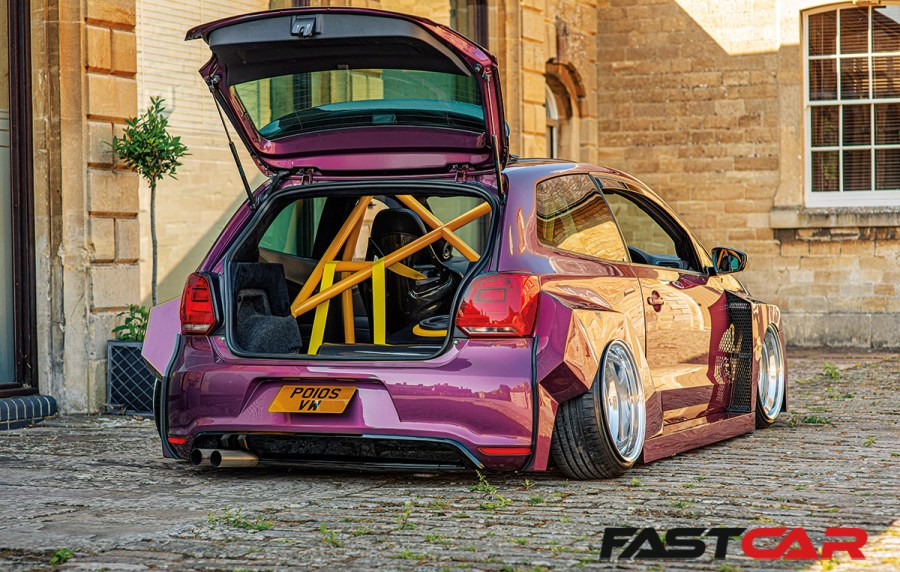Inspired by a mix of digital artwork and rally-bred styling, Curtis Anderson’s 270hp, wide body VW Polo shows the most ambitious ideas don’t have to stop at the virtual drawing board.
In the long and varied history of modified project cars, few things have broadened our creative horizons quite as much as Photoshop. It’s a virtual workshop unconstrained by budgets or physics, where everything from simple wheel swaps and resprays to imagination-run-wild rebuilds can be explored with a few clicks of a mouse, often with photo-realistic results. Digital nip-tucks have become a common source of inspiration for the next steps in a project, but reality-bending renders rarely evolve into road-going reality. It’s rarer still when that happens at home.
Curtis Anderson’s box-arched, frame-laying wide body VW Polo has the sort of on-road presence that you could mistake for a virtual brainstorm if it dropped into your social media feed. However, we can assure you that this one is very much a reality. And he story behind it becomes even more interesting when, as he explains, that break-the-internet visual impact it has today is the project coming full circle.
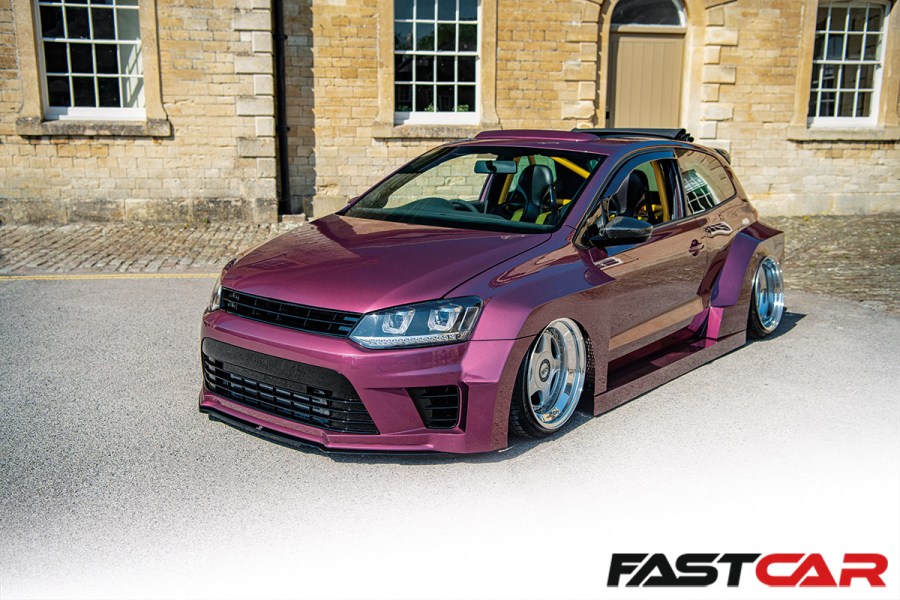
How the wide body VW Polo design came about
“I saw a VW Polo render done by Kyzyl Saleem [@the_kyza]. As we’d got a couple of mutual friends, I asked him if he could modify it so it could be built – just as a one-off,” he tells us. “He put me onto Hugo Silva Designs, and we went back and forth for a week every evening adapting the files until it was right. Then I printed them out, stuck them on the wall around the car and got to work…”
It might surprise you to hear this, but the Polo’s bespoke bodylines weren’t crafted from a lifetime of experience in coachbuilding. Although Curtis studied mechanics in college, he took a detour into property maintenance having decided he’d prefer to keep working on cars as a hobby rather than make it pay the bills. That mechanical interest has bubbled away in the meantime, though, mostly materialising in numerous bagged-and-remapped BMW-badged daily drivers but with a noticeable Polo habit on the side.
These have always been a bit hands-on. The Mk3 (6N) Polo he bought at 16 is still in the garage nine years later, part way through a postponed but not abandoned GTI engine swap. This one is his second Mk5 (6R) project. Picked up as a 70hp entry-spec model, it inherited seats, air bags and – at first – the Mercedes Centra split rims from its crashed predecessor and started out as a lightly altered daily drive until things took an unexpected detour.
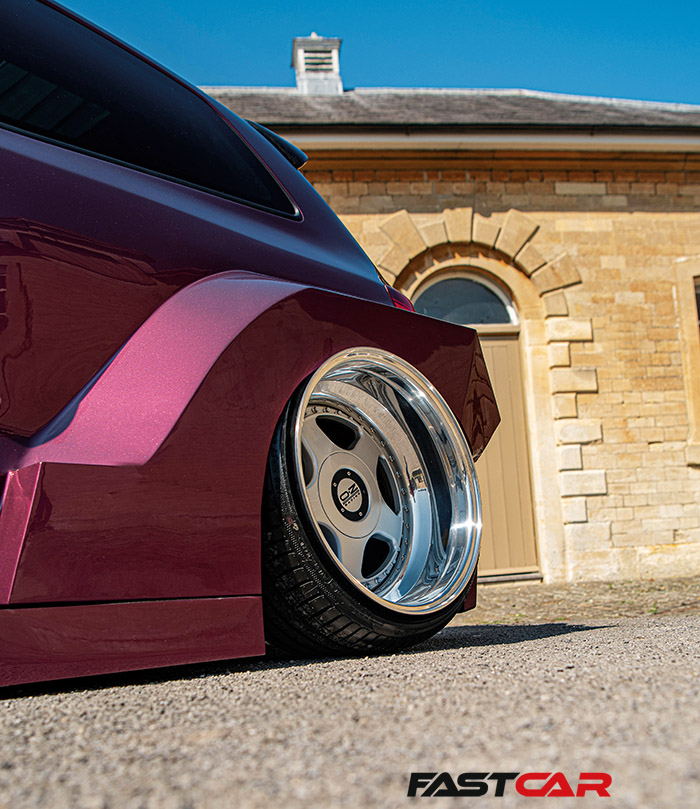
Building the car
“A few years ago, I ended up doing some work for a bodyshop in Milton Keynes,” Curtis continues. “They needed a hand, and I was working four-on, four-off shifts, so on two of my days off I’d come in and help out. After a few weeks they offered to paint the car. It wasn’t planned, but I wanted to take advantage of the free paint, so I started cutting the car up and welding on extra metal to wide body it. I didn’t have a clue what I was doing.”
If that was true, then it didn’t show. That first rebuild added five inches of distinctive steel overfender at each corner, stretching the Polo’s bodywork like something out of Japan’s Bōsōzoku scene, and it wasn’t done blindly. Aired out, that extra metalwork wrapped tightly around OZ Futura wheels, stepped up to 17s with 4.5-inch lips at the front and with barrel-flipped rears to stagger the fitment even further. Guesswork isn’t worth the risk when you’re still planning to use it daily. Yes, really.
“I was still putting a lot of miles on the car at that point, so I wrapped it in yellow when the paint started to get tired. Then, the night before Players, I hit a badger and my front end exploded so I parked it until I could sort everything out. It was two years before I started building it again and we’d moved house in that time. The car was too wide to fit in the garage, so it sat outside for a while – the first thing I did was cut the arches off,” he tells us.
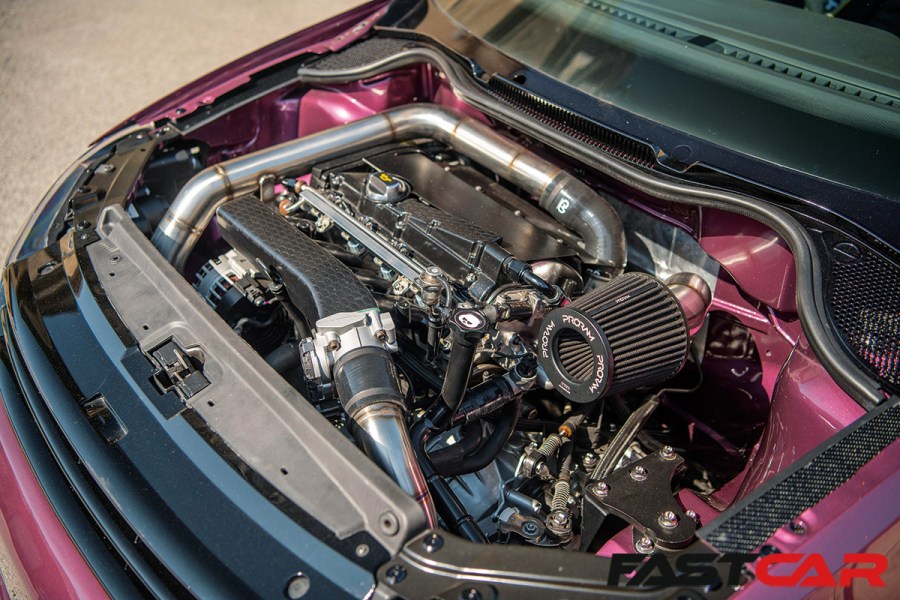
Engine swap
With no specific deadline to get it back on the road, the rebuild didn’t stop with a visual rethink. Mates’ cars had moved up in the power stakes, and wringing eleven tenths out of the Polo’s gutless factory engine was losing its appeal. Alternatives are fairly tried and tested here. SEAT equipped the Ibiza FR with the same 150hp 1.8T used in the previous-generation (9N3) Polo GTI and, although the 6R GTI got the twin-charged 1.4 TFSI instead, the mounting points are identical. Bolting the engine into the later chassis was a ten-minute job. Making it start and run was a little more time-consuming.
“The Ibiza has the same ECU plugs, but none of the pins match up with the Polo loom. Luckily one of my friends is an auto electrician. He’s also done a few 2.0 TFSI swaps into Caddys, so I got him to send me the wiring diagrams to compare. I stared at them for about half an hour before I gave in, messaged him and asked for help,” laughs Curtis.
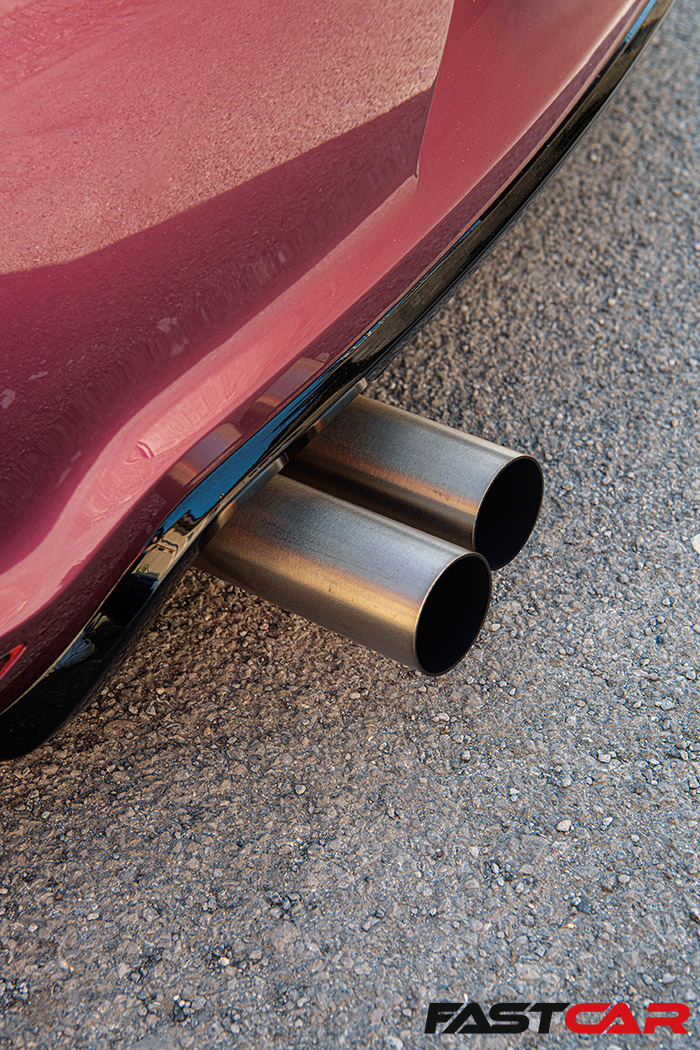
Tuning the power
Naturally, the conversion wasn’t entirely OE-style. The Polo rumbled back into life after two nights of temporarily splicing the two looms together with connector blocks, before being stripped again so the wiring could be extended and tucked it out of sight. Within the shaved bay, the installation is as focused on details as it was on performance. The BAM inlet manifold to flip the throttle body to the other end of the rocker cover, so the boost hoses run down either side of the engine. Custom remapped at Tuning Technics and running a larger K04 turbo, the Polo makes a much healthier 270hp with no need to wring it out.
“My daily is a mapped E92 BMW 335d with nearly 400hp and the torque on that is crazy. I was telling myself not to get too hyped about the new engine because it wouldn’t feel like that,” he smiles. “Maybe it’s the noise. Maybe it’s the tinniness, but doesn’t feel far off. With the BMW you look down at your speedo and you’re going quick without knowing it. With the Polo you don’t even want to look at the speedo, because you don’t want to take your eyes off the road.”
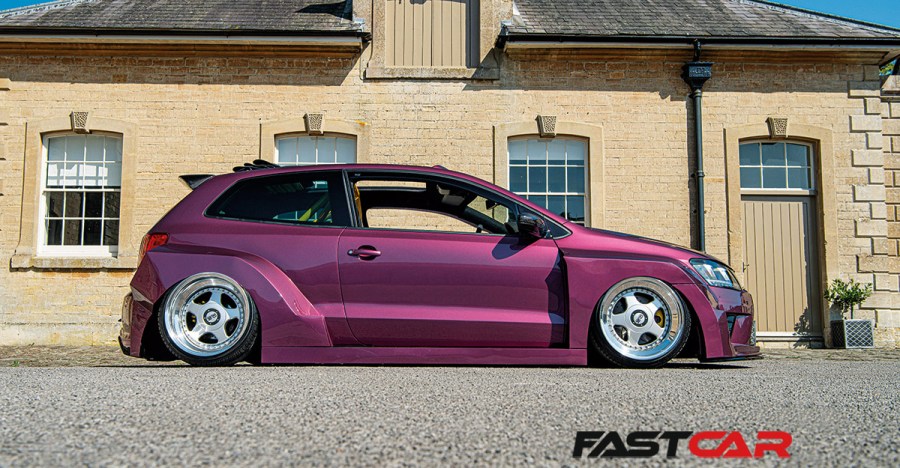
Working on the wide body
While the engine was a fairly familiar swap, the bodywork was a leap into the unknown. Those bespoke renders had brought the Polo’s future self to life from every useful angle, and a metal fabricator friend convinced Curtis that the real thing could be built at home. This wasn’t quite as collaborative as he’d expected – when a rough R32 Skyline project started soaking up his mate’s time, he finished the Polo himself.
“We cut out as much of the original metalwork as we needed so that when I air out it’s the subframe and rear axle hitting the floor,” he explains. “Then I welded in new metal where I’d cut it out so it’s fully tubbed and water-tight, and I made the arches from there. Technically the car rolls when it’s fully aired out, so I’d be able to drive it if the edge of the arches wasn’t in the lip of the wheels.”
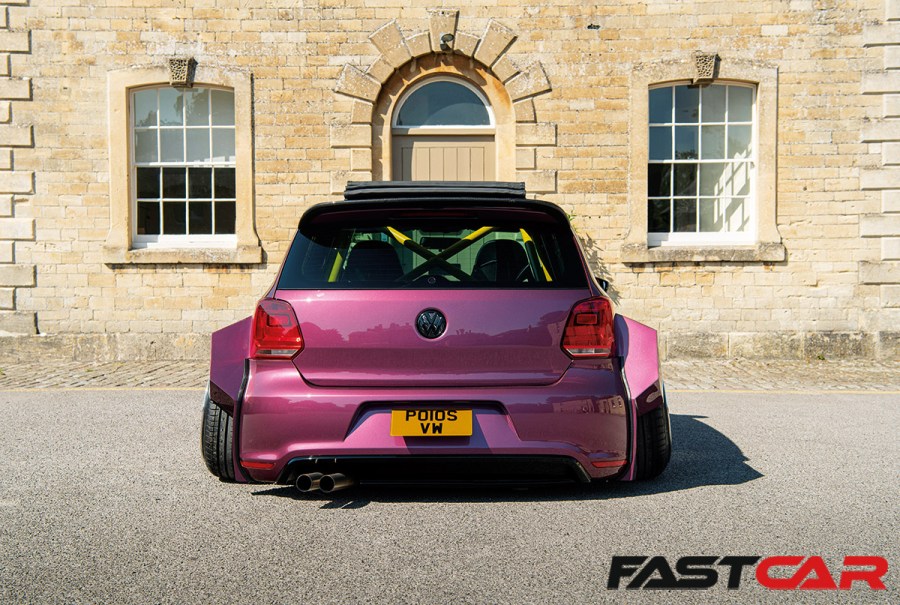
Rally car inspiration
There’s more than a hint of factory rally car woven into that new look. The front bumper started has a Volkswagen part number, as it’s lifted from the rare 2.0 TFSI-powered Polo R WRC homologation special. However, it’s been widened and fitted with an extra vent to match the arches. Behind it is a custom-made tubular crash bar, which dials out any flexing on the road and offers somewhere to mount the intercooler. Given that a replacement bumper could cost anywhere north of £900 without the additional custom work, we’d call that a worthwhile insurance policy.
Of course, the original digital render wasn’t designed to work in the real world. The re-worked version cut factory-style shut lines separating the bumpers, wings and side skirts. Curtis also had to find a solution for the fuel flap which had disappeared behind the passenger side rear arch. There’s still a factory fuel tank under the cabin. But the top of the filler neck is angled into a cap inside the boot. It’s a simpler solution than running new lines to a fuel cell, but he admits it draws confused looks at the pump.
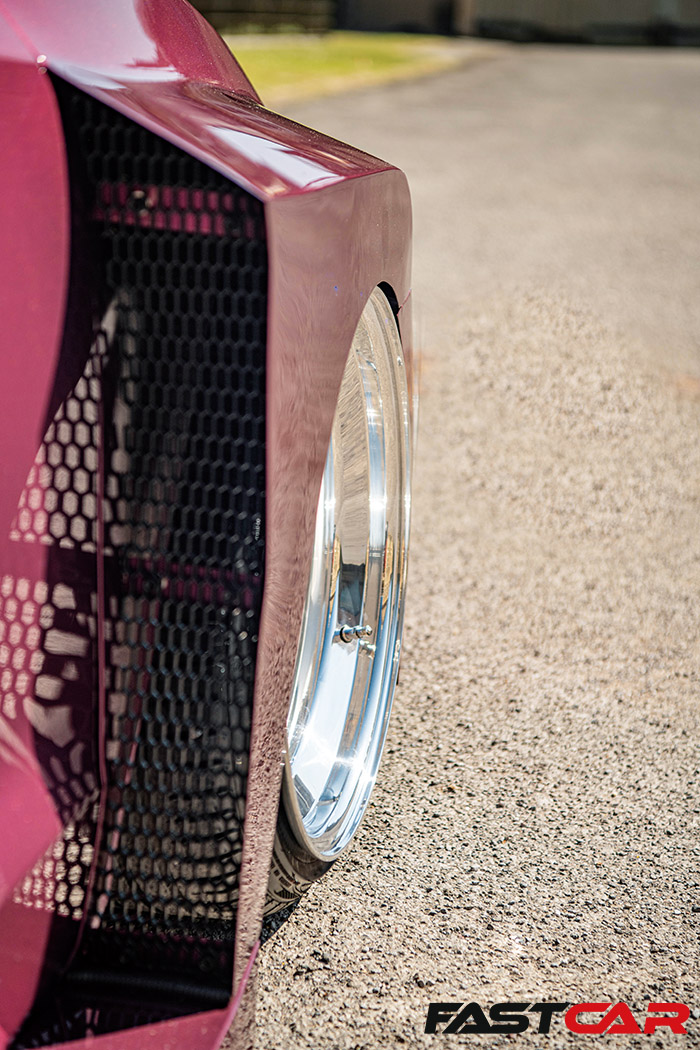
Painting the wide body VW Polo
The final step was finding a trustworthy painter to make the most of that hard work. After months of searching, Curtis bumped into a Sheffield-based painter at Ultimate Dubs who was setting up shop on her own and had capacity to take on the Polo’s unique paintwork in evenings and weekends while the business got off the ground. The bare shell returned home a year later, and the quality of the finish speaks for itself; loosely inspired by a Lamborghini purple but actually based on a BMW paint code with a few secret additions to make it unique.
“When the car was going back together in my garage, there would be about 20 people in there every Friday, Saturday and Sunday night. Sometimes it was too much, because then nothing gets done. Everyone is messing about and chatting, and you’d have to fight your way through 15 people to get to the toolbox. But I wouldn’t have it any other way,” he says.
“In the winter the gas heater was always on and we were always drinking tea. In the group chat one of my friends called it the biscuit factory. It stuck, and whenever we talk about going into the garage we call it ‘Bikky HQ’. It’s like a communal place for my friends, and we’re building an E46 in there at the minute.”
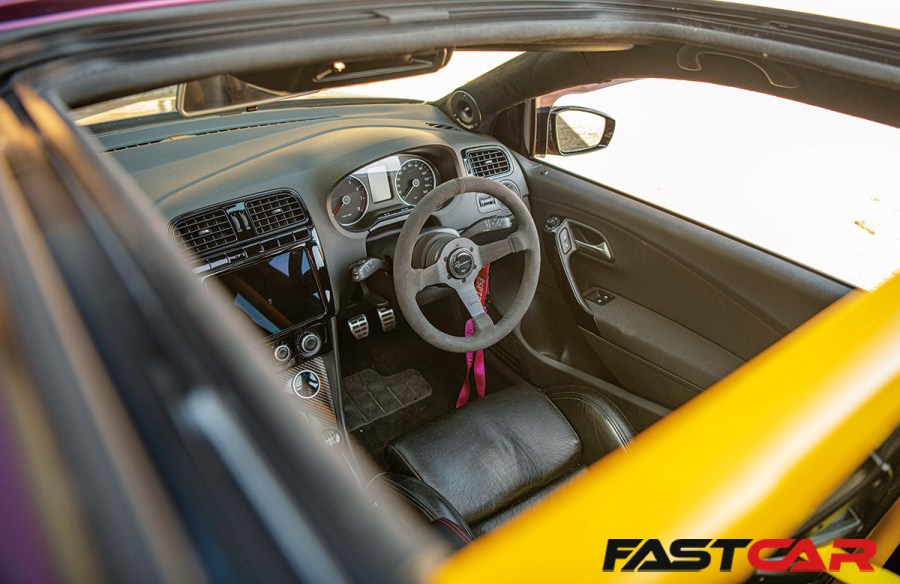
Interior
Reassembly was building on good foundations. The Ibiza engine donor gave up its larger front brakes and discs to replace the rear drums, and most of the still interior was still in good shape. Curtis had already cut a fabric rag top into the Polo’s roof, while the install and custom roll cage were matched to the yellow-wrapped bodywork it had before it lost its fight with the badger. There’s a new in-dash iPad install and multi-gauge pod to keep an eye on the engine, while the Porsche Carrera GT style recliners now have four-point TRS harnesses which are colour coded to the cage.
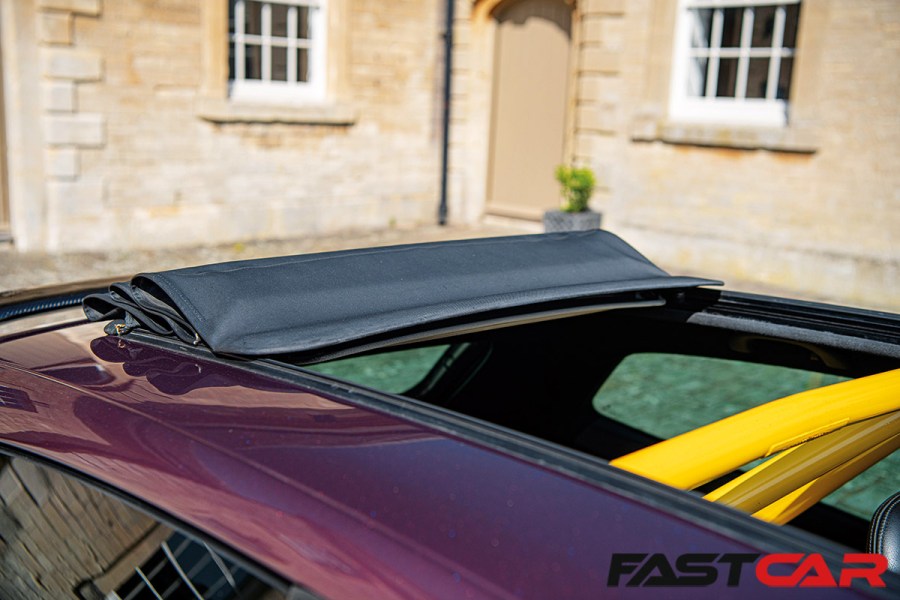
What’s next?
“I have a spare interior and the plan was to that trimmed and fit it instead,” he says. “However, it’s already a nice place to be, without having to spend another £4,000 or £5,000 trimming something else. I’m really happy with how the yellow and purple work together – if it’s not broken, don’t fix it…”
He’s had plenty of opportunities to spot anything that does need fixing. The Polo has dropped back into a cycle of regular use following the rebuild, and not just locally – including a 900-mile trip to the Ultrace show in Poland under its own steam. If he isn’t out and about in the works van, then chances are you’ll find enjoying the end result of hard work only few would even think of taking on – let alone tasking with pan-European road trips.
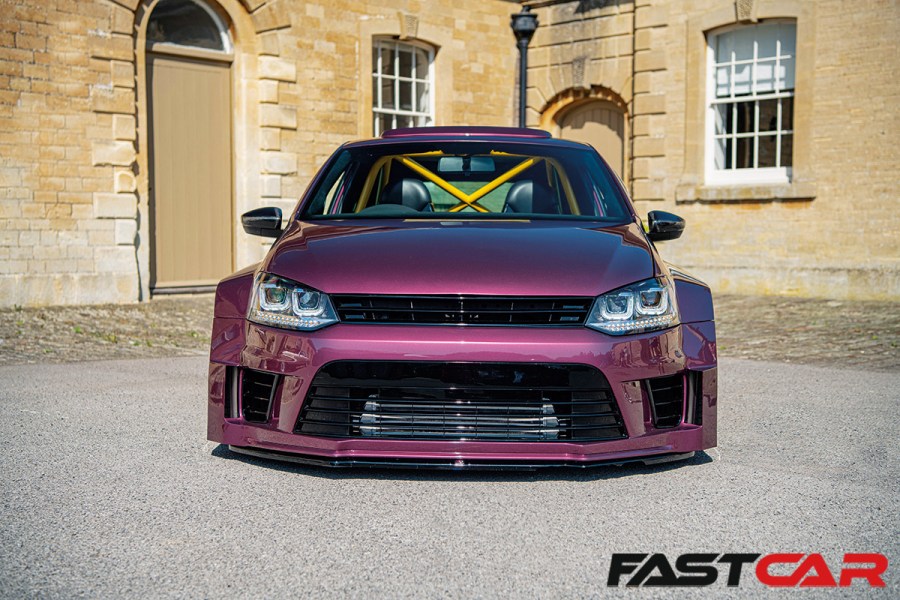
“I didn’t spend near enough two years in the garage building this to put it on the back of a trailer and watch it get towed around,” smiles Curtis. “Maybe when I’m 70 years old and I’ve got a collection of cars I’ll put them on a trailer and take them to shows, but I don’t see myself stopping driving these cars.”
We’d add building them onto that list. With no plans to sell up, and that all-too-familiar sense of never quite being finished, the wide body VW Polo long-term evolution isn’t over yet. After all, there’s plenty of creative scope to roll the car back into its virtual workshop for another rebuild at some point. Given that Curtis isn’t shy when it comes to taking on the work himself, who knows where that’ll lead.
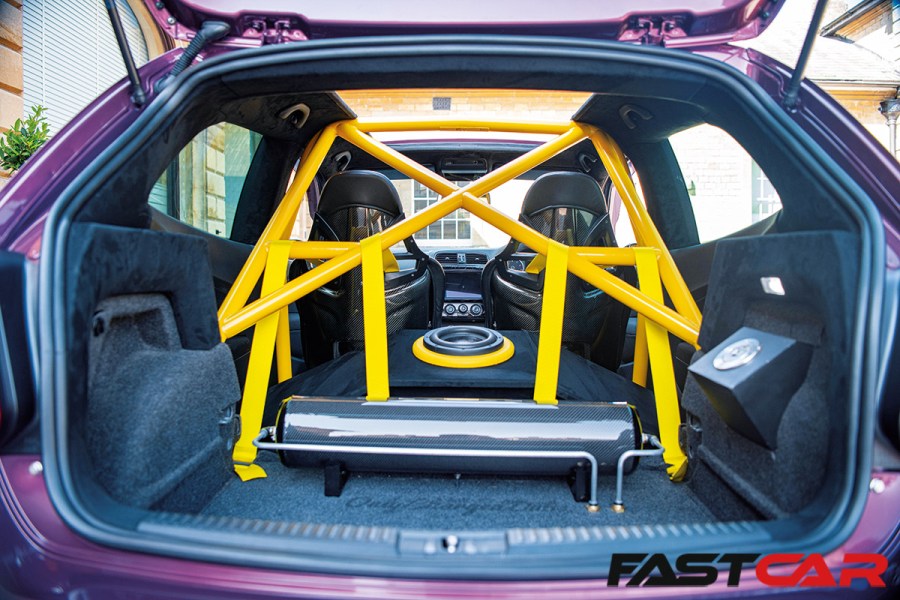
Tech Spec: Wide Body VW Polo
Engine:
1781cc; four-cylinder 20-valve turbo from SEAT Ibiza FR (6L); K04 turbocharger; BAM inlet manifold; custom ‘BIKKY HQ’ Ramair filter; custom boost pipes; custom turbo-back exhaust system; Tuning Technics engine map; custom expansion tank; coolant lines; brake lines and fuel lines; fully smoothed and wire-tucked.
Chassis:
OZ Futura wheels with SRR 16-17-inch step-up kit and flipped rear barrels; 225/35 (rear) Accelera PH-1 tyres; Air Lift Performance air ride with carbon fibre air tank; Ibiza FR brake conversion (front and rear).
Exterior:
One-off metal wide-body kit; genuine Polo WRC front bumper widened to match; full respray in custom purple; Open Air fabric roof; fuel filler relocated inside the boot; Golf R style headlights; carbon fibre roof spoiler; gloss black and carbon fibre tailgate badge
Interior:
Custom roll-cage (painted yellow) with rear bench removed; DesignTek Porsche Carrera GT carbon fibre reclining bucket seats; yellow four-point TRS harnesses; Renown Time Trial steering wheel; black suede headlining and pillar trim; B and C-pillar seatbelt holes smoothed; carbon fibre gauge mount with Prosport gauges.
ICE:
Custom iPad install; Alphard tweeters in custom A-pillar pods; Edge Street Series 8-inch subwoofer in custom black suede and yellow leather-trimmed box.
With thanks to Performance VW. Words: Alex Grant. Photos: Chuff Media.

